Nestle Marketing Strategies and Demographics
VerifiedAdded on 2020/02/24
|7
|1369
|66
AI Summary
This assignment examines Nestle Australia's recent marketing campaigns and product launches, focusing on their target audience and potential success. It also explores how worldwide demographic shifts, particularly the aging baby boomer population, are creating opportunities for international businesses in various industries.
Contribute Materials
Your contribution can guide someone’s learning journey. Share your
documents today.

NESTLE
Assignment Week
Name of Student
Name of Institute
Assignment Week
Name of Student
Name of Institute
Secure Best Marks with AI Grader
Need help grading? Try our AI Grader for instant feedback on your assignments.

2
NESTLE
Table of Contents
Task 1:.......................................................................................................................................3
Task 2:.......................................................................................................................................5
Reference...................................................................................................................................7
NESTLE
Table of Contents
Task 1:.......................................................................................................................................3
Task 2:.......................................................................................................................................5
Reference...................................................................................................................................7
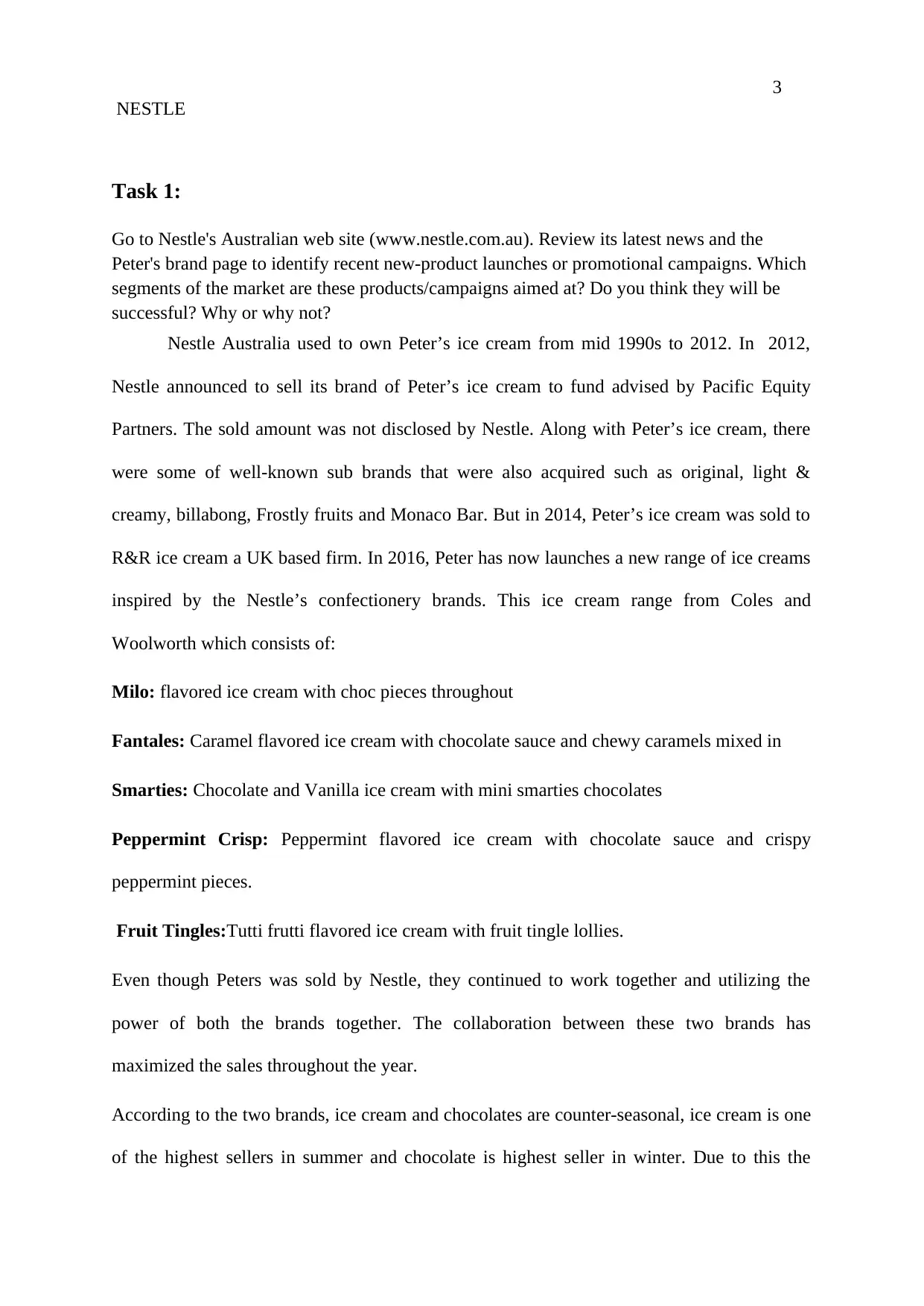
3
NESTLE
Task 1:
Go to Nestle's Australian web site (www.nestle.com.au). Review its latest news and the
Peter's brand page to identify recent new-product launches or promotional campaigns. Which
segments of the market are these products/campaigns aimed at? Do you think they will be
successful? Why or why not?
Nestle Australia used to own Peter’s ice cream from mid 1990s to 2012. In 2012,
Nestle announced to sell its brand of Peter’s ice cream to fund advised by Pacific Equity
Partners. The sold amount was not disclosed by Nestle. Along with Peter’s ice cream, there
were some of well-known sub brands that were also acquired such as original, light &
creamy, billabong, Frostly fruits and Monaco Bar. But in 2014, Peter’s ice cream was sold to
R&R ice cream a UK based firm. In 2016, Peter has now launches a new range of ice creams
inspired by the Nestle’s confectionery brands. This ice cream range from Coles and
Woolworth which consists of:
Milo: flavored ice cream with choc pieces throughout
Fantales: Caramel flavored ice cream with chocolate sauce and chewy caramels mixed in
Smarties: Chocolate and Vanilla ice cream with mini smarties chocolates
Peppermint Crisp: Peppermint flavored ice cream with chocolate sauce and crispy
peppermint pieces.
Fruit Tingles:Tutti frutti flavored ice cream with fruit tingle lollies.
Even though Peters was sold by Nestle, they continued to work together and utilizing the
power of both the brands together. The collaboration between these two brands has
maximized the sales throughout the year.
According to the two brands, ice cream and chocolates are counter-seasonal, ice cream is one
of the highest sellers in summer and chocolate is highest seller in winter. Due to this the
NESTLE
Task 1:
Go to Nestle's Australian web site (www.nestle.com.au). Review its latest news and the
Peter's brand page to identify recent new-product launches or promotional campaigns. Which
segments of the market are these products/campaigns aimed at? Do you think they will be
successful? Why or why not?
Nestle Australia used to own Peter’s ice cream from mid 1990s to 2012. In 2012,
Nestle announced to sell its brand of Peter’s ice cream to fund advised by Pacific Equity
Partners. The sold amount was not disclosed by Nestle. Along with Peter’s ice cream, there
were some of well-known sub brands that were also acquired such as original, light &
creamy, billabong, Frostly fruits and Monaco Bar. But in 2014, Peter’s ice cream was sold to
R&R ice cream a UK based firm. In 2016, Peter has now launches a new range of ice creams
inspired by the Nestle’s confectionery brands. This ice cream range from Coles and
Woolworth which consists of:
Milo: flavored ice cream with choc pieces throughout
Fantales: Caramel flavored ice cream with chocolate sauce and chewy caramels mixed in
Smarties: Chocolate and Vanilla ice cream with mini smarties chocolates
Peppermint Crisp: Peppermint flavored ice cream with chocolate sauce and crispy
peppermint pieces.
Fruit Tingles:Tutti frutti flavored ice cream with fruit tingle lollies.
Even though Peters was sold by Nestle, they continued to work together and utilizing the
power of both the brands together. The collaboration between these two brands has
maximized the sales throughout the year.
According to the two brands, ice cream and chocolates are counter-seasonal, ice cream is one
of the highest sellers in summer and chocolate is highest seller in winter. Due to this the
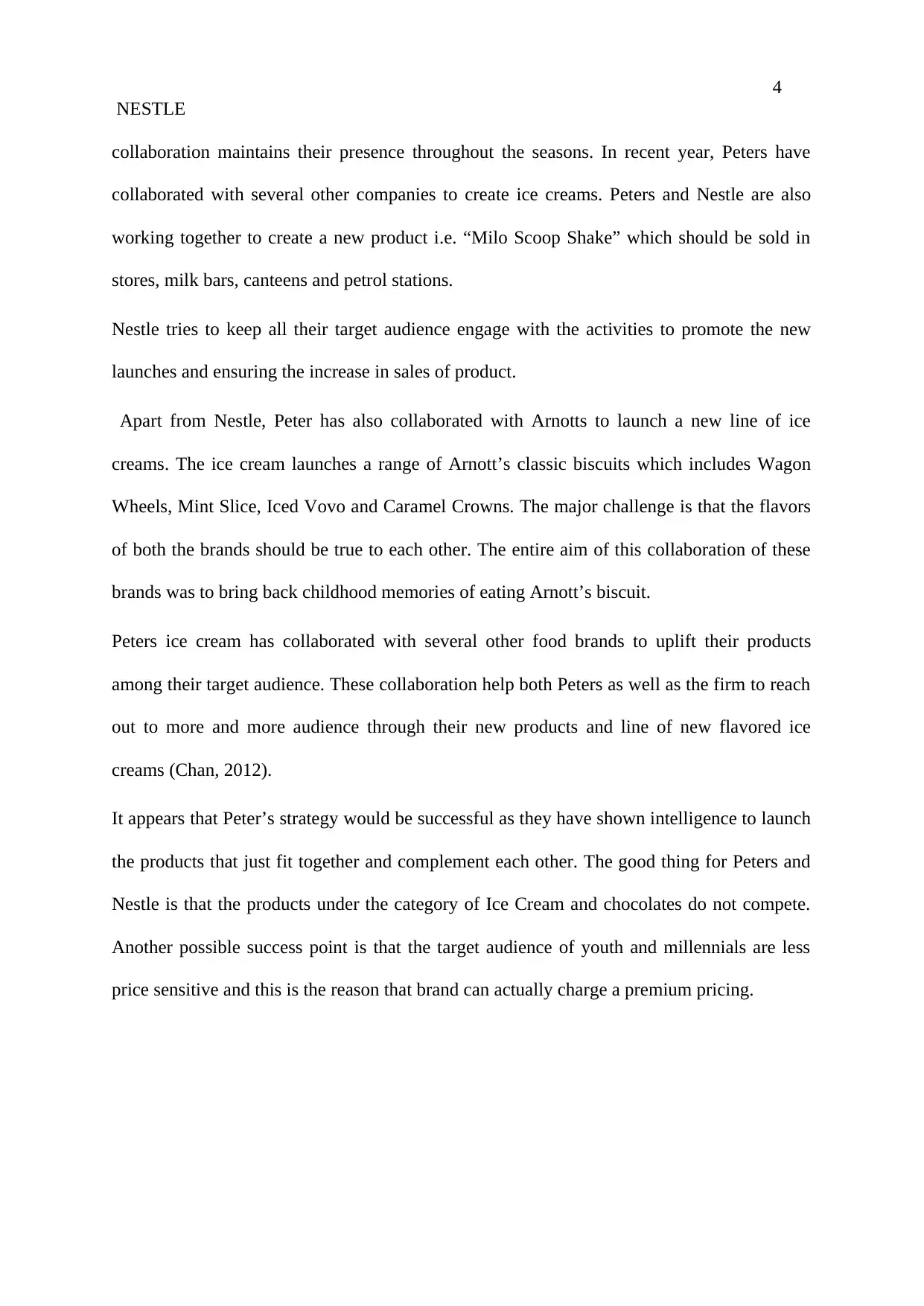
4
NESTLE
collaboration maintains their presence throughout the seasons. In recent year, Peters have
collaborated with several other companies to create ice creams. Peters and Nestle are also
working together to create a new product i.e. “Milo Scoop Shake” which should be sold in
stores, milk bars, canteens and petrol stations.
Nestle tries to keep all their target audience engage with the activities to promote the new
launches and ensuring the increase in sales of product.
Apart from Nestle, Peter has also collaborated with Arnotts to launch a new line of ice
creams. The ice cream launches a range of Arnott’s classic biscuits which includes Wagon
Wheels, Mint Slice, Iced Vovo and Caramel Crowns. The major challenge is that the flavors
of both the brands should be true to each other. The entire aim of this collaboration of these
brands was to bring back childhood memories of eating Arnott’s biscuit.
Peters ice cream has collaborated with several other food brands to uplift their products
among their target audience. These collaboration help both Peters as well as the firm to reach
out to more and more audience through their new products and line of new flavored ice
creams (Chan, 2012).
It appears that Peter’s strategy would be successful as they have shown intelligence to launch
the products that just fit together and complement each other. The good thing for Peters and
Nestle is that the products under the category of Ice Cream and chocolates do not compete.
Another possible success point is that the target audience of youth and millennials are less
price sensitive and this is the reason that brand can actually charge a premium pricing.
NESTLE
collaboration maintains their presence throughout the seasons. In recent year, Peters have
collaborated with several other companies to create ice creams. Peters and Nestle are also
working together to create a new product i.e. “Milo Scoop Shake” which should be sold in
stores, milk bars, canteens and petrol stations.
Nestle tries to keep all their target audience engage with the activities to promote the new
launches and ensuring the increase in sales of product.
Apart from Nestle, Peter has also collaborated with Arnotts to launch a new line of ice
creams. The ice cream launches a range of Arnott’s classic biscuits which includes Wagon
Wheels, Mint Slice, Iced Vovo and Caramel Crowns. The major challenge is that the flavors
of both the brands should be true to each other. The entire aim of this collaboration of these
brands was to bring back childhood memories of eating Arnott’s biscuit.
Peters ice cream has collaborated with several other food brands to uplift their products
among their target audience. These collaboration help both Peters as well as the firm to reach
out to more and more audience through their new products and line of new flavored ice
creams (Chan, 2012).
It appears that Peter’s strategy would be successful as they have shown intelligence to launch
the products that just fit together and complement each other. The good thing for Peters and
Nestle is that the products under the category of Ice Cream and chocolates do not compete.
Another possible success point is that the target audience of youth and millennials are less
price sensitive and this is the reason that brand can actually charge a premium pricing.
Secure Best Marks with AI Grader
Need help grading? Try our AI Grader for instant feedback on your assignments.
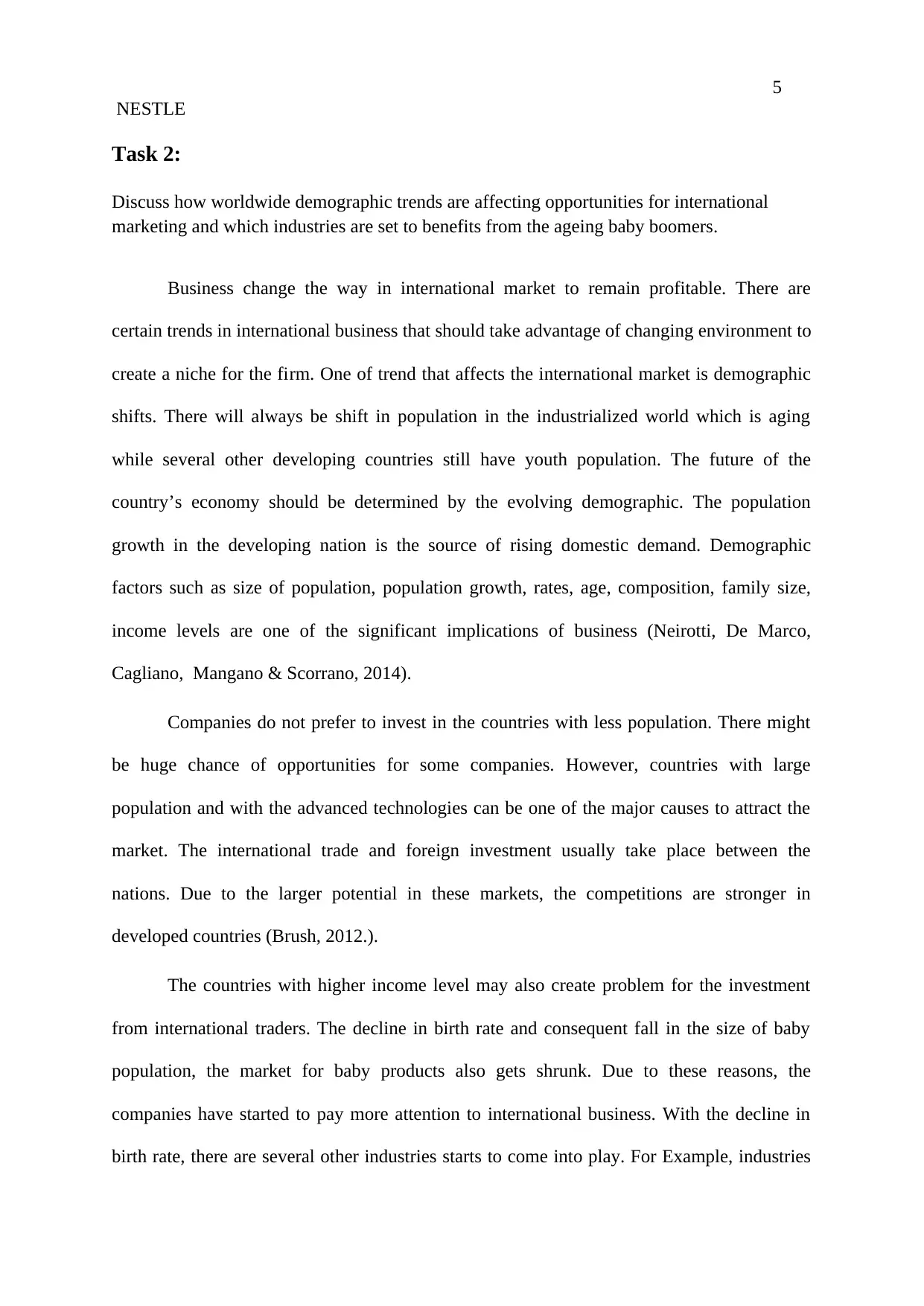
5
NESTLE
Task 2:
Discuss how worldwide demographic trends are affecting opportunities for international
marketing and which industries are set to benefits from the ageing baby boomers.
Business change the way in international market to remain profitable. There are
certain trends in international business that should take advantage of changing environment to
create a niche for the firm. One of trend that affects the international market is demographic
shifts. There will always be shift in population in the industrialized world which is aging
while several other developing countries still have youth population. The future of the
country’s economy should be determined by the evolving demographic. The population
growth in the developing nation is the source of rising domestic demand. Demographic
factors such as size of population, population growth, rates, age, composition, family size,
income levels are one of the significant implications of business (Neirotti, De Marco,
Cagliano, Mangano & Scorrano, 2014).
Companies do not prefer to invest in the countries with less population. There might
be huge chance of opportunities for some companies. However, countries with large
population and with the advanced technologies can be one of the major causes to attract the
market. The international trade and foreign investment usually take place between the
nations. Due to the larger potential in these markets, the competitions are stronger in
developed countries (Brush, 2012.).
The countries with higher income level may also create problem for the investment
from international traders. The decline in birth rate and consequent fall in the size of baby
population, the market for baby products also gets shrunk. Due to these reasons, the
companies have started to pay more attention to international business. With the decline in
birth rate, there are several other industries starts to come into play. For Example, industries
NESTLE
Task 2:
Discuss how worldwide demographic trends are affecting opportunities for international
marketing and which industries are set to benefits from the ageing baby boomers.
Business change the way in international market to remain profitable. There are
certain trends in international business that should take advantage of changing environment to
create a niche for the firm. One of trend that affects the international market is demographic
shifts. There will always be shift in population in the industrialized world which is aging
while several other developing countries still have youth population. The future of the
country’s economy should be determined by the evolving demographic. The population
growth in the developing nation is the source of rising domestic demand. Demographic
factors such as size of population, population growth, rates, age, composition, family size,
income levels are one of the significant implications of business (Neirotti, De Marco,
Cagliano, Mangano & Scorrano, 2014).
Companies do not prefer to invest in the countries with less population. There might
be huge chance of opportunities for some companies. However, countries with large
population and with the advanced technologies can be one of the major causes to attract the
market. The international trade and foreign investment usually take place between the
nations. Due to the larger potential in these markets, the competitions are stronger in
developed countries (Brush, 2012.).
The countries with higher income level may also create problem for the investment
from international traders. The decline in birth rate and consequent fall in the size of baby
population, the market for baby products also gets shrunk. Due to these reasons, the
companies have started to pay more attention to international business. With the decline in
birth rate, there are several other industries starts to come into play. For Example, industries
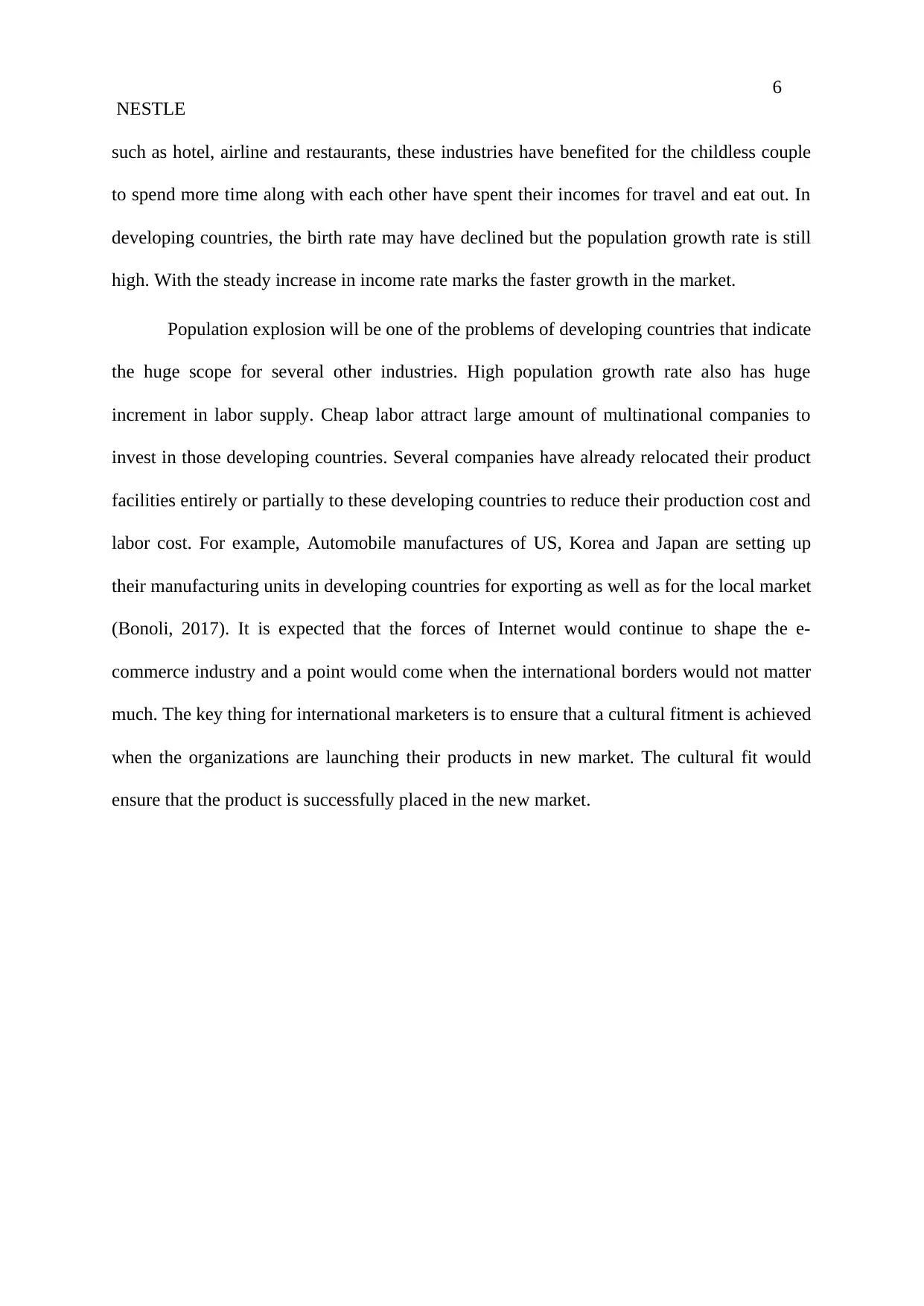
6
NESTLE
such as hotel, airline and restaurants, these industries have benefited for the childless couple
to spend more time along with each other have spent their incomes for travel and eat out. In
developing countries, the birth rate may have declined but the population growth rate is still
high. With the steady increase in income rate marks the faster growth in the market.
Population explosion will be one of the problems of developing countries that indicate
the huge scope for several other industries. High population growth rate also has huge
increment in labor supply. Cheap labor attract large amount of multinational companies to
invest in those developing countries. Several companies have already relocated their product
facilities entirely or partially to these developing countries to reduce their production cost and
labor cost. For example, Automobile manufactures of US, Korea and Japan are setting up
their manufacturing units in developing countries for exporting as well as for the local market
(Bonoli, 2017). It is expected that the forces of Internet would continue to shape the e-
commerce industry and a point would come when the international borders would not matter
much. The key thing for international marketers is to ensure that a cultural fitment is achieved
when the organizations are launching their products in new market. The cultural fit would
ensure that the product is successfully placed in the new market.
NESTLE
such as hotel, airline and restaurants, these industries have benefited for the childless couple
to spend more time along with each other have spent their incomes for travel and eat out. In
developing countries, the birth rate may have declined but the population growth rate is still
high. With the steady increase in income rate marks the faster growth in the market.
Population explosion will be one of the problems of developing countries that indicate
the huge scope for several other industries. High population growth rate also has huge
increment in labor supply. Cheap labor attract large amount of multinational companies to
invest in those developing countries. Several companies have already relocated their product
facilities entirely or partially to these developing countries to reduce their production cost and
labor cost. For example, Automobile manufactures of US, Korea and Japan are setting up
their manufacturing units in developing countries for exporting as well as for the local market
(Bonoli, 2017). It is expected that the forces of Internet would continue to shape the e-
commerce industry and a point would come when the international borders would not matter
much. The key thing for international marketers is to ensure that a cultural fitment is achieved
when the organizations are launching their products in new market. The cultural fit would
ensure that the product is successfully placed in the new market.
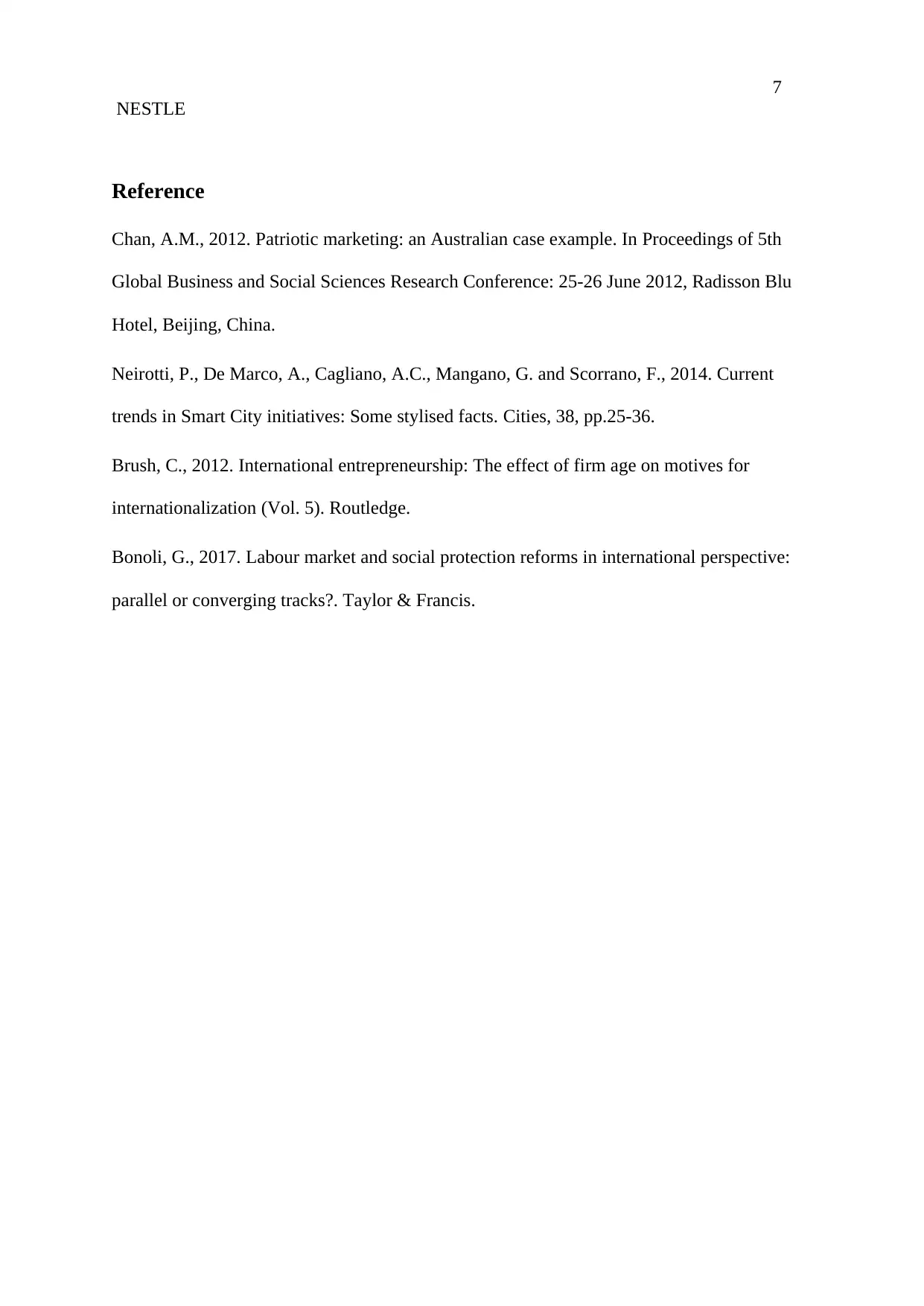
7
NESTLE
Reference
Chan, A.M., 2012. Patriotic marketing: an Australian case example. In Proceedings of 5th
Global Business and Social Sciences Research Conference: 25-26 June 2012, Radisson Blu
Hotel, Beijing, China.
Neirotti, P., De Marco, A., Cagliano, A.C., Mangano, G. and Scorrano, F., 2014. Current
trends in Smart City initiatives: Some stylised facts. Cities, 38, pp.25-36.
Brush, C., 2012. International entrepreneurship: The effect of firm age on motives for
internationalization (Vol. 5). Routledge.
Bonoli, G., 2017. Labour market and social protection reforms in international perspective:
parallel or converging tracks?. Taylor & Francis.
NESTLE
Reference
Chan, A.M., 2012. Patriotic marketing: an Australian case example. In Proceedings of 5th
Global Business and Social Sciences Research Conference: 25-26 June 2012, Radisson Blu
Hotel, Beijing, China.
Neirotti, P., De Marco, A., Cagliano, A.C., Mangano, G. and Scorrano, F., 2014. Current
trends in Smart City initiatives: Some stylised facts. Cities, 38, pp.25-36.
Brush, C., 2012. International entrepreneurship: The effect of firm age on motives for
internationalization (Vol. 5). Routledge.
Bonoli, G., 2017. Labour market and social protection reforms in international perspective:
parallel or converging tracks?. Taylor & Francis.
1 out of 7
Related Documents
Your All-in-One AI-Powered Toolkit for Academic Success.
+13062052269
info@desklib.com
Available 24*7 on WhatsApp / Email
![[object Object]](/_next/static/media/star-bottom.7253800d.svg)
Unlock your academic potential
© 2024 | Zucol Services PVT LTD | All rights reserved.
